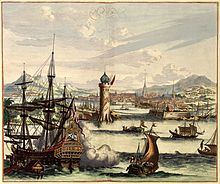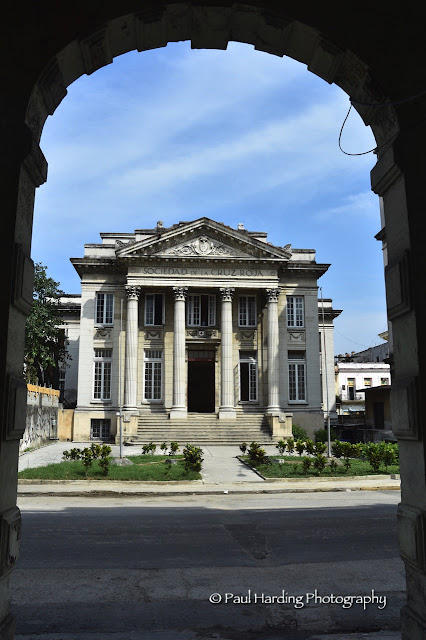In early 2017 we had opportunity to explore Cuba! Staying in the capital city of Havana is a must for first time visitors - a city of contradiction in time and cars and buildings. (*NB: if you see a photo you admire, by all means click on to see an enlarged version to be dragged on to your desktop to keep!)
One minute you are in the 1950s with old American cars passing every few minutes and the next staring at 16th Century Spanish architecture!
Havana is a sprawling metropolis covering over 280 square miles with 2.1 million inhabitants, the largest also in the Caribbean. The city was founded by the Spanish in the 16th Century as its starting point for the conquest of the western continents. After the plundering of lands and islands the treasure filled galleons set off across the Atlantic for Spain from the port of Havana. In 1592 King Phillip ll granted Havana the title of 'city' and began fortification of the town and harbour. By 1740 Havana had become Spain's largest shipyard with the only dry dock in the New World.
In 1898 the U.S. Battleship Maine was sunk in Havana's harbour starting the Spanish-American War.
The city of Havana can be described in three different sections: Old Havana or Vedado, City Center and new suburban districts, all attracting over a million visitors now annually.
Morro Castle guards the entrance to Havana Harbour was designed by Italian engineer, Juan Bautista originally under the control of Spain and built in 1589 in response to raids on Havana Harbour.
Ships from all over the world used Havana as a trading port where their goods could be sent over to Spain. Ships and crews all had to be provisioned for the long journey across the Atlantic Ocean. The city expanded tremendously in the 17th century where building were constructed from materials available from the island. In 1649 a fatal epidemic arrived from Cartagena, Columbia affecting a third of the population. By the 18th century the population had exceeded 70,000.
The city was captured by the British in June of 1762 with 50 ships and 11,000 men during the Seven Years War. Trade was opened up to the Americas and Caribbean colonies. With the Treaty of Paris Havana was returned to Spain while Britain was given Florida. This is when the fortification of Havana became the heaviest fortification in the Caribbean. On January 15, 1796 the remains of Christopher Columbus were transported to Cuba from Santo Domingo staying here until 1898 when they traveled to Seville's Cathedral after Spain's loss of Cuba. In 1863 the city walls were knocked down for the expansion of Havana.
The Revolution of 1959 ushered in the leadership of Fidel Castro who abruptly expropriated all private property and industry under a communist model backed by the Soviet Union. By 1966 -69 the Government had nationalized all privately owned business. After the collapse of the Soviet Union in 1991 Cuba suffered an economic downturn but the regime sustained.

The recent government turned to tourism to replace the millions in subsidies that used to flow from the Soviet Union. Old Havana started a restoration, slowly but surely the old town will be the major attraction once again, as only a small portion of the city receives a facelift.
Having existed for over 500 years Havana boasts some of the most diverse styles in architecture. Since the revolution however many fine old structures fell into disrepair and have collapsed causing death and injury due to lack of maintenance. The old streets still display the old gas lighting in public places from 1848.
What captivates us for days on end is the street life of Havana. Miles of side streets in Old Havana each holding sights and sounds to keep us exploring the a city that once must have been the jewel of the Caribbean and only time before its return.
Now after years of decline the people hold on to life as it was. Fruit markets, roadside cafe's. Take a horse & buggy or better still a Coco or bicycle taxi as a fine escort around the city.
It is a feast of contradictions. Art and splendor mixed with age and decrepit walkways. One tries to stay in high-end hotels or be subjected to sub-standard in the western world. The main street from Morro Castle into the city center one finds wonderful artists with very reasonable pricing of real talent.
There is scant Internet although Cubans are seeking connection to the outside world and hungry to explore a world they may never see. We discover some fine restaurants and the food vastly improved from tourism of past years. The street vendors offer some lovely fruit and wall art will stop one in your tracks to admire.
Havana ofcourse has the cars! Step back in time and arrive in the 1950s for a car show to please any history buff. Some on their last legs always seem to find new life!

We explore the countryside into Vinales where the valley spreads over 51 square miles. Here we discovered the 'real Cuba' where fields are still ploughed by oxen and tobacco grows abundantly. Cuba being agriculturally rich produces vast quantities of sugar and coffee. The 'pregnant palms' catch our eye as we near the town.
Tobacco takes approximately 40 days to mature when it is harvested. Taken into drying houses the leaves become marketable after about 80 days.
We walk the roads just outside of town and find farmers who show us their wares and willing to chat with us about their way of life. The atmosphere here is wonderful and good to be away from the city's bustle.

We drive past vast fields of heavily laden mango trees, their harvest this year avoiding tropical storms should be amazing?
Rising from the valley floor are limestone cliffs exceeding 300 meters in height where a new tourist market is created with hiking and rock climbing. The highest elevation on the island of Cuba is over 6,400-feet.
In 1939 writer Ernest Hemingway crossed the waters in his boat Pilar for Cuba. Joined by Martha Gellhorn they rent a 15 acre property 15 miles outside Havana called Finca Vigia or Lookout Farm.
She inspired him to begin For Whom the Bell Tolls in March 1939 and finished in July 1940 and nominated for the Pulitzer Prize. Hemingway during his travels suffered numerous injuries from car wrecks, bush fires and ski accidents. While in Africa on their way to photograph Murchison Falls their plane struck a utility pole and crashed into the bush. Attempting to reach medical care in Entebbe the next day their second plane exploded on take-off, suffering further burns and head injuries. The house in Cuba became very busy with visitors and tourists making Hemingway unhappy with life there and thinking of a move to Idaho. He left Cuba the last time in July 1960 when I first arrived in the Bahamas! He left art work and manuscripts in a bank vault in Havana. After the Bay of Pigs Invasion in 1961 his property was expropriated by the Government along with four to six thousand books!
We leave after only exploring for a week. So much more to see of the Cuban countryside where postings here will continue!
Stay tuned here and click on 'Follow by Email' to receive updates! ~ Thanks for following & please feel free to share the pages!
'Older Posts' link at the bottom of each page will take you to past adventures - enjoy!


















































































































AWESOME photography and journalism. I felt as if I was there with you and certainly wish I was. Well done! I especially loved that particular lady that was featured in many of your pictures. She looked very special! :-) Patti D.
ReplyDeleteThanks Patti! Glad you enjoyed :)
DeleteWonderful, thanks for sharing!
ReplyDeleteAgain...amaizing pictures and a complete "Adventure Travel". Well done!!!
ReplyDeleteSee you again one day!!! :)
DeleteLoved this - both the wonderful photos and really interesting commentary. Say hi to Melissa, please.
ReplyDeleteThanks and will do! :)
DeleteExcellent! Thanks for the history lesson. Awesome pics, as always.
ReplyDelete